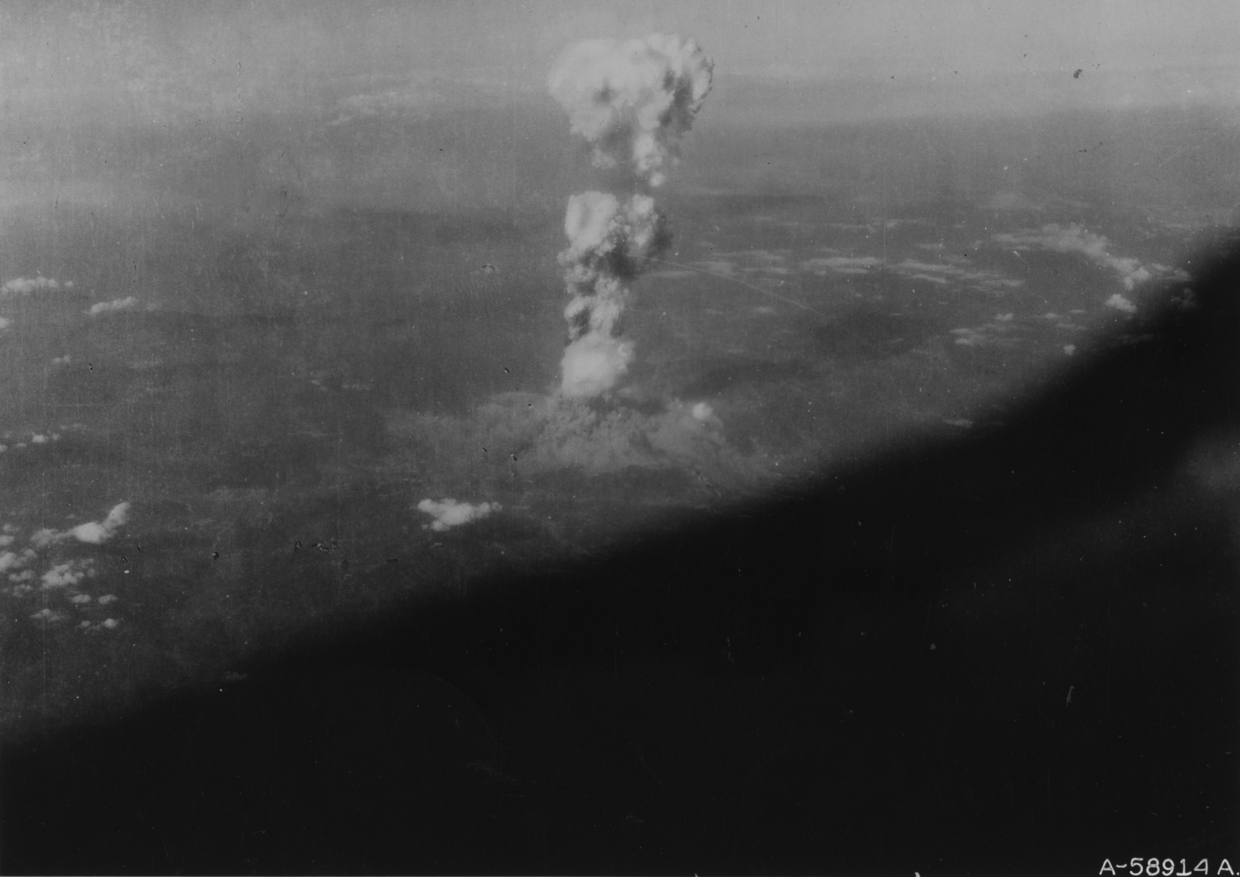Scott Ritter
is a former US Marine Corps intelligence officer and author of 'SCORPION KING: America's Suicidal Embrace of Nuclear Weapons from FDR to Trump.' He served in the Soviet Union as an inspector implementing the INF Treaty, in General Schwarzkopf’s staff during the Gulf War, and from 1991-1998 as a UN weapons inspector. Follow him on Twitter @RealScottRitter

Enola Gay Boeing B-29 on 6 August 1945, during the final stages of World War II, became the first aircraft to drop an atomic bomb. © Getty Images / Photo 12
As the world reflects on the decision by the US to drop two atomic bombs on Japan at the end of World War II, the reality is that the US nuclear enterprise remains the greatest threat to world peace.
Seventy-five years ago this week, two American B-29 ‘Superfortress’ bombers departed Tinian Island, in the northernmost part of the Mariana Islands, some 1,500 miles south of Tokyo, armed with the world’s newest and most horrific weapon: the atomic bomb. On August 6, a B-29 nicknamed the ‘Enola Gay’ dropped a single bomb containing 64 kilograms of highly enriched uranium over the Japanese city of Hiroshima. The bomb, nicknamed ‘Little Boy,’ detonated with the force of 15 kilotons of TNT. At least 66,000 people were killed outright, with another 69,000 wounded, many of whom subsequently died of their injuries.
Two days later a second B-29, nicknamed the ‘Bockscar,’ dropped a bomb containing 6.4 kilograms of plutonium over the city of Nagasaki. This weapon, nicknamed ‘Fat Man,’ detonated with a force of 21 kilotons, killing some 39,000 Japanese outright and wounding another 25,000, most of whom, like those injured in Hiroshima, later died from their wounds.
ALSO ON RT.COMJohn Pilger: Another Hiroshima is coming – unless we stop it now
American historians have struggled with the morality of dropping weapons that could destroy a city and its population in one mighty blast. Over the years, a consensus has been reached that justifies the horror of using the atomic bomb on the grounds that it helped shorten the war with Japan and, in doing so, saved hundreds of thousands of American lives that would have been lost in any invasion of the main Japanese islands, along with the lives of millions of Japanese, who would have died defending their homeland.
The problem with this narrative is that it provides an inaccurate picture of what really transpired. Certainly, the math regarding expected casualties in the case of an invasion of Japan is factually accurate, as far as estimates go. However, the reality was that Japan was on the cusp of surrendering and, had the US offered conditional terms replicating the post-war arrangement eventually reached by General MacArthur (the retention of the Imperial family, and a modicum of Japanese self-governance), there is every reason to believe that the Japanese would have surrendered without the US resorting to a costly campaign of conquest.

The fact of the matter is Truman’s inner circle, including Secretary of State James Byrnes and Secretary of War Henry Stimson, were in favor of dropping the atomic bomb on Japanese cities not so much because it would shorten the current war with Japan, but primarily because it would help deter a future war with the Soviet Union.
Byrnes believed that “Russia might be more manageable” in a post-war reality shaped not by the theoretical possibility of an atomic bomb, but the demonstrated destructive capacity of the new weapon. As General Leslie Groves, the military director of the Manhattan Project that produced the two American bombs, relayed to the scientists involved, “the whole purpose of this project was to subdue the Russians.”
ALSO ON RT.COMUS is stuck in Cold War thinking; Plan to spend Russia & China ‘into oblivion’ in arms race will bankrupt only America
This distinction is critical to understanding the role played by nuclear weapons in American nuclear posture and policy today. Doctrine, like organizations and people, are heavily influenced by the circumstances of their birth. There is a huge distinction between the calculation required to justify using a weapon for the purpose of shortening a war and saving lives, and that used to seek to intimidate a potential future opponent by demonstrating the destructive capability of a weapon through the annihilation of two cities, and their respective populations, that otherwise need not have been targeted for destruction.
Americans like to embrace the narrative of the use of the two atomic bombs that targeted Hiroshima and Nagasaki as a perverse act of humanitarianism – we had to kill hundreds of thousands in order to save millions. Seen in this light, the continued possession of nuclear weapons by the United States is a necessary evil, as their existence helps prevent, through deterrence, the future employment of these terrible weapons of mass destruction.
But when viewed through a lens that reflects the reality of the genesis of the atomic bomb – that it was a force of intimidation the power of which had to be demonstrated through the murder of hundreds of thousands of people, most of whom were civilians who otherwise would have survived – the atomic bomb and its progeny were no longer a necessary evil, but rather pure evil personified.
The United States has long struggled with the need to balance the notion of ‘war made easy’ through the existence of nuclear weapons and the temptation to use them that such a philosophy promotes, and the harsh reality of retaliation at the hands of other nuclear powers should it be inclined to use them. The fact that, over the years, the US has been tempted to use nuclear weapons to resolve difficult non-nuclear conflicts (Korea, Vietnam, and Iraq come to mind) only underscores the reality that intimidation, and not deterrence, is their principal value.
The fact that the US continues to design and deploy nuclear weapons based on their ‘usability’ should send a chill down the neck of every American citizen, and indeed of the neck of every citizen of the world. This is especially so now, given the current ambivalence of the US to the kind of arms control that previously helped reduce the risk of inadvertent nuclear conflict. In the past 20 years, the US has withdrawn from the Anti-Ballistic Missile Treaty and the Intermediate-Range Nuclear Force Treaty, and is on the cusp of allowing the New Strategic Arms Reduction Treaty to expire without a replacement.
Instead of doubling down on trying to revive arms control, the US seems focused on flexing its muscle through the deployment of new ‘small yield’ warheads on submarine-launched ballistic missiles (SLBMs). It’s also ‘up-warheading’ and flight-testing Minuteman III intercontinental ballistic missiles armed with three multiple independently targetable re-entry vehicles – despite the fact the operational Minuteman III force is deployed with only a single warhead.
American politicians and military planners may seek to mollify a worried world by insisting that these actions, and others like it, are meant only to bolster the deterrent capability of the US nuclear enterprise. But the world should not be fooled. Seventy-five years ago, the United States murdered hundreds of thousands of Japanese for the sole purpose of seeking to intimidate Russia. A recent exercise involving the newly deployed ‘low-yield’ SLBM, in which the Secretary of Defense practiced the weapons-release procedures in a scenario involving the targeting of Russian forces in Europe, must be viewed in the shadow of this history. Intimidation, not deterrence, was, is and always will be the driving force behind America’s nuclear arsenal. Like any schoolyard bully, the concern isn’t if the US will use these weapons, but when.
https://www.rt.com/op-ed/497209-intimidation-deterrence-nuclear-bombing-japan/
Counter Information published this article following the Creative Commons rule. If you don't want your article to appear in this blog email me and I will remove it asap.




















No comments:
Post a Comment